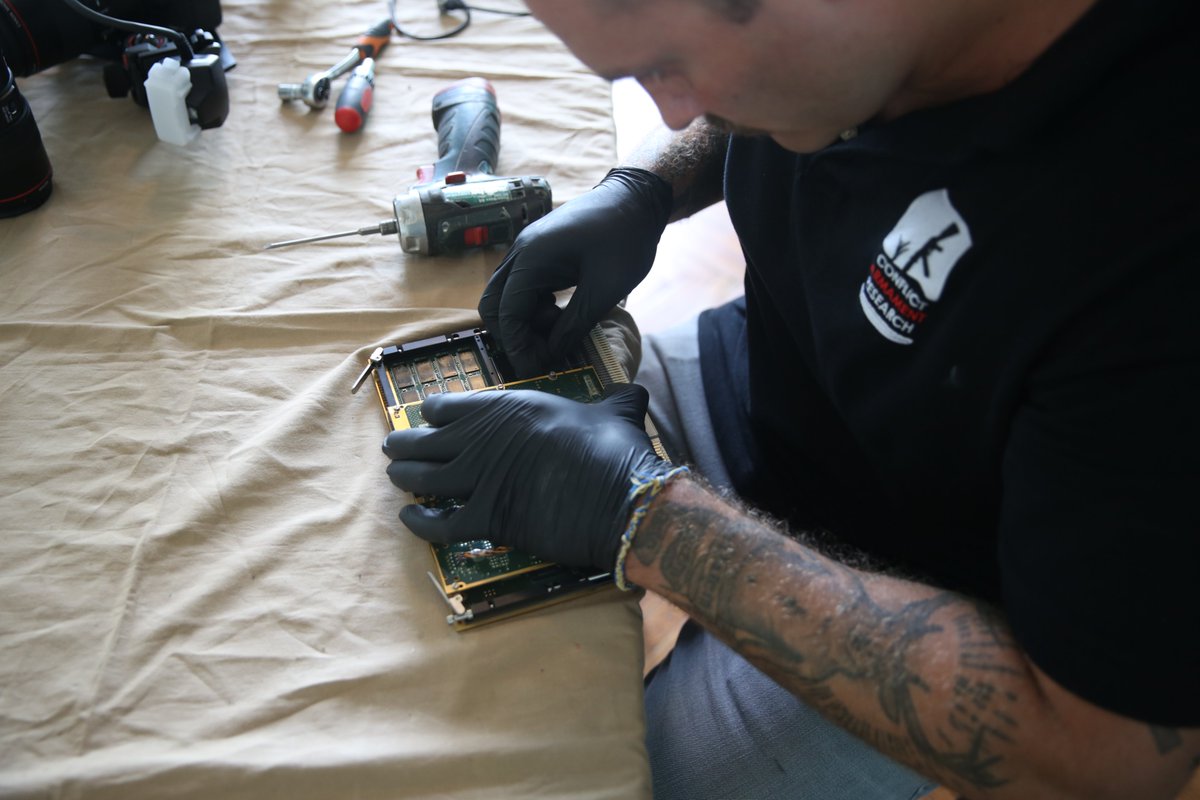
In July 2022, @conflictarm returned to #Ukraine to continue to document components of Russian weapons. There, we made an interesting discovery. Follow along... 1/19
We documented parts of the SN-99 satellite navigation systems of three different Russian cruise missiles: the 3M14, the Kh-59, and the Kh-101 2/19 

We had already documented the satellite navigation system of a 9M544 rocket back in May 2022, and it looked exactly the same 3/19 

This is the manufacturer’s pamphlet, detailing the specs of the SN-99 satellite navigation system navis.ru/assets/files/S… 4/19
Each layer of circuit board had the same components, made by the same non-Russian manufacturers, arranged in the same way, and manufactured between 2012 and 2020 (more details in our latest report: storymaps.arcgis.com/stories/239f75…) 5/19
We also found that parts of the “Baget” on-board computers of the Kh-101 missile and Ka-52 helicopter are identical and made of the same non-Russian components 6/19 

This indicates that the Russian defence industry uses identical sets of components across different weapon systems. The application of new or existing measures could restrict Russia’s ability to acquire these components and produce such weapon systems in the future 7/19
Looking for more information on the “Baget”-series of Russian on-board computers, I found this on the website of the Moscow Aviation Institute, department of radiolocation, radionavigation, and on-board radio electronic equipment: kaf401.rloc.ru/ASORLD/Baget.p… 8/19
Reading this document on the “Baget”, the reliance of the Russian defence industry on commercially-available electronic components for a variety of weapon systems appears to be based on a conscious change in approach 9/19 

The document explains a “change in the approach to making technical policies for the creation of computer on-board or ground-based specialized systems” 10/19 

The document states: “The new approach includes a wide use of ready-made open-type hardware and software computer technologies, previously widely tested and/or standardized in the market of general industrial civilian applications.” 11/19
The document also states that Commercial-off-the-shelf (COTS) technologies “allow using a huge stock of ready-made off-the-shelf hardware and software components;... 12/19
... to develop and produce, if necessary, own original modules and software, while concentrating the main efforts on the implementation and maintenance of own target system and development of applied software in the shortest possible time.” 13/19 

The document also indicates that “for the implementation of special systems today in the vast majority of cases it is a question of selecting and adapting a number of specific computer COTS-technologies, rather than developing a new end-to-end technology” 14/19
Now, put this in perspective with what @Ascii211 said here to @johnismay about the SN-99 systems @conflictarm documented in May and July: nytimes.com/2022/09/04/us/… 15/19
“The Russian navigation system resembles the open-source architecture of GPS receivers, which is not subject to federal restrictions regarding the sale and export of defense articles” 16/19 nytimes.com/2022/09/04/us/…
Could it be that Russia becoming more resilient to potential sanctions also dictated this choice of open-source and off-the-shelf technologies in weapon development? 17/19
If so, then identifying the components inside Russian weapons, as @conflictarm is doing in #Ukraine, is only the first step (so far we've identified 144 non-Russian manufacturers of more than 650 unique component models) ukraine-2021-itrace.hub.arcgis.com/pages/case-stu… 18/19
Then comes the identification of the acquisition networks, which remains our main objective. 19/19
• • •
Missing some Tweet in this thread? You can try to
force a refresh





